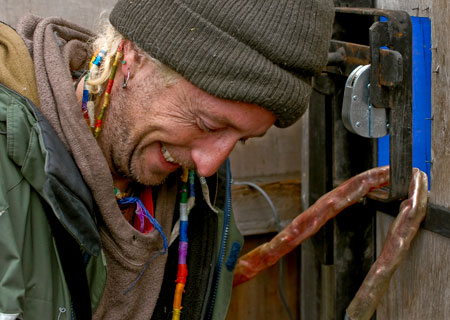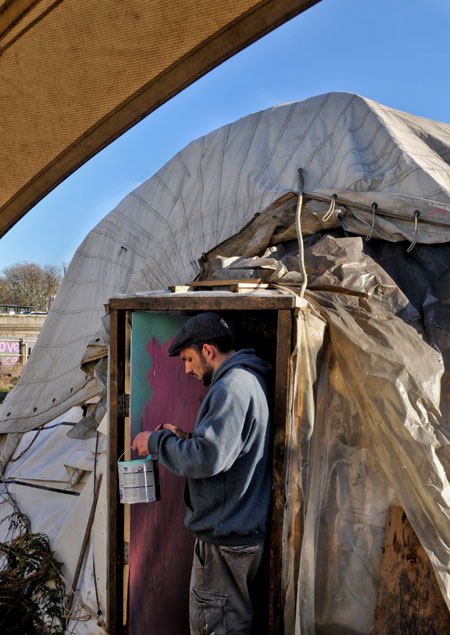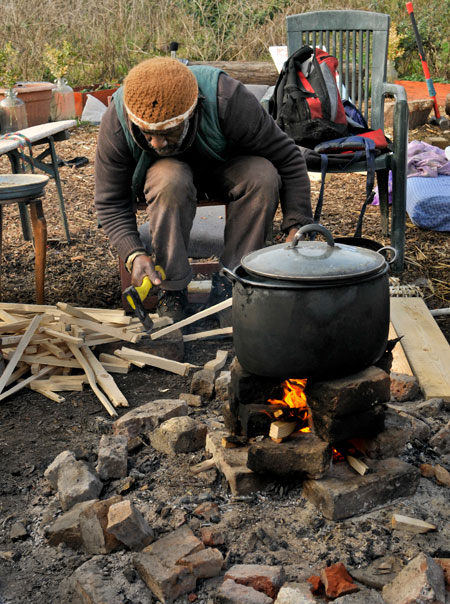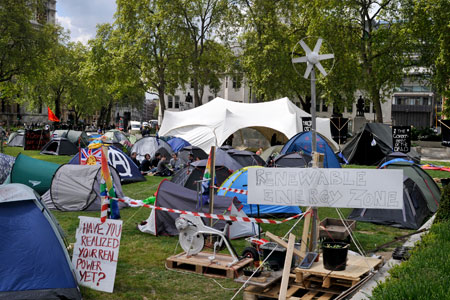 |
|
An activist negotiates with police officers through the locked gate of the seized land in Kew-Bridge. © Jack Laurenson
|
Source: New Internationalist
I scurried up to a higher vantage point to get a better view of the site the activists had just sneaked into and occupied. Most were now sitting in a circle amongst the undergrowth having a planning discussion, while others guarded the locked gate. ‘This is it,’ I thought as the police eventually arrived and started banging aggressively on the nine-foot high wooden gate: ‘It’s all gonna kick off!’
In preparation for imminent siege, a handful of the younger and more energetic eco-warriors went to defend the entrance against attack. The activists hadn’t thought to bring boiling oil or catapults and the police had apparently forgotten their battering ram, so the drama at the gate quickly fizzled out. The police, apparently realizing it was a civil matter between the landowner and protesters, subsequently left. The cheerful and victorious squatters quickly began pitching tents, erecting signs and clearing the site of much debris and rubbish.
In an effort to highlight the pressing global issues of land rights, climate change and lack of sustainability and bio-diversity within our modern and ever-developing societies, The Land Is Ours campaign swooped on the derelict plot of land in Brentford, London, and began establishing an Eco-Village community. Occasionally the grumpy pessimist, I was not expecting they would have much success.
A movement gathering momentum
I was, of course, to be proved dramatically wrong. Writing this article a year on from the day the village was founded in early June 2009, I’m impressed and somewhat humbled by how much the Eco-Village achieved and, although they have recently been evicted, how a new national movement seems to be gaining momentum.
I returned to the village in December 2009 after a long summer working in India, and some six months after they took over the land. Looking down onto the site from Kew Bridge was almost a familiar vision. It resembled not the image I recalled from the day back in June when the site was first occupied, but more like the many eclectic slum villages that are scattered around all of India. Messy, chaotic and under-developed, but also warm and welcoming, with an obvious community rapport that is lacking in much of ‘developed’ society. The Eco-Village is situated in a relatively affluent London suburb and obviously lacks many of the socio-economic troubles of the poverty-stricken Indian slum communities, but it still reflects many of the more pleasant aspects of these crowded and atmospheric townships.
The village effectively functioned as a democracy, all important decisions being made by consensus agreement. Everybody seemed to get along and to have a role to play, be it cooking, maintenance, teaching, building or art and hospitality. Much effort had obviously gone into the village’s physical appearance and the meticulously-planned wood-chip paths which wound around the village between the small herb and vegetable gardens and individually hand-constructed wooden homes. They were as much works of modern art as practical, semi-permanent abodes.
Much of the village was decorated with beautiful crafts and sculptures, all made from sustainable materials like wood, mud and flora. The fences around the site were plastered with murals and paintings, slogans and inspirational quotations from history; Gandhi was very popular. Colourful banners and flags hung from people’s huts; they flapped and flickered in the wind. As spring began to arrive and the weather began to improve, the villagers planted more flowerbeds and gardens all over the site. These quickly bloomed with the helping hand of some rain and sunshine. A smell of fresh grass, water and wood smoke mingled with the overwhelming atmosphere of pollution from the nearby A205.
 |
|
A new coat of paint is applied to the door of the Eco-Village communal area, November 2009. © Jack Laurenson
|
Cindy, one of the founders at the Kew-Bridge Eco-Village, told me that the movement simply wanted to demonstrate that it was possible to live differently. ‘It would’ve been easier to establish it in the countryside, but it wouldn’t have had the same effect and not as many people would have seen it. We wouldn’t have got the message across: even living in a city you can dramatically reduce your carbon footprint and be much more sustainable.’ The village could have grown much more of its own food had it been located outside of London, and would have had access to more naturally occurring resources like wood, wild berries and mushrooms. Being on an old industrial site with poor quality, heavily polluted soil meant much of the village’s food was salvaged waste from supermarkets.
Gareth, another founding member and full-time activist, told me that supermarkets all over the country throw out enough perfectly good food to feed entire communities. Indeed, I saw this for myself. ‘You wouldn’t believe the stuff they throw out. We’ve had people come back with bags of steak and crates of beer, boxes full of bread and milk, not to mention tonnes of vegetables. You have to be careful obviously, especially with meat, but much of it is chucked out well before its expiry date.’ A truly damning indictment of wasteful corporations and bureaucracy, and ever more potent in my mind, having recently returned from a drought-stricken, starving India.
St George is the dragon
The site, which was unused and left derelict for over 20 years, was a prime one acre patch right next to the River Thames. Since obtaining it in 2003, the St George development company were happy to capitalize on its value by leaving it empty and overgrown while they finished luxury developments elsewhere. In recent years, planning applications for the site were declined because St George continually failed to reach compulsory standards regarding important issues like required percentages of affordable housing in developments. Subsequent discussions saw St George’s plans approved. One resident said to me that he suspected ‘somebody had probably received a fat brown envelope.’
 |
|
Michael, one of the eco-villagers, lights the evening fire and boils water for green tea, April 2010. © Jack Laurenson
|
The local council admitted it was not willing to use public money to pay a £250,000 legal bill to challenge the conclusion in court, despite unanimous condemnation from all of the local community groups. Justice it would seem, is expensive.
Local people I spoke to felt rightfully disenfranchised and abandoned. The new proposal from St George consists of 164 flats in a huge nine-storey development containing only 13 per cent affordable housing. The development mostly consists of luxury penthouses and apartments. One local woman, Kaz Mackie, a cancer sufferer, spoke to a local journalist of her feelings; ‘It is mainly disabled and elderly people who live on the ground floor and they are going to be submerged into darkness. I take great pleasure in being able to see the moon from my window and now that is being taken away from me. I feel our views have been completely ignored.’ St George politely ignored my requests for an interview.
Local residents are quick to state the abandoned site was an eyesore, but quicker to condemn the plans for yet another block of expensive flats. ‘What we need is more affordable social housing or community gardens and parks to rejuvenate the area, not luxury apartments and expensive bars,’ one resident told me in the pub next door to the site. A charming and lively family-run pub that is sadly a planned casualty of the development: it’s being demolished.
The Eco-Village quickly became a strong and popular community catalyst and the free organic café was regularly home to locals sipping green tea or school children learning about permaculture, biodiversity, peace and art. Michael, one of the villagers and a general handyman around the community, was responsible for rigging up many of the structures for the wind-power and installing solar panels. He told me that he thinks the village had a strong impact on the local area; ‘It’s changing the local community’s way of thinking towards more ethical living. People want to be more sustainable in their everyday lives, even in cities, but obviously everyone can’t give everything up and live here… The village is giving an insight into things that aren’t generally taught in schools… And the attention we are getting is perhaps the local people’s last bastion of hope of stopping this development from going ahead.’
 |
|
Having been finally evicted from Kew – after 11 months – the activists descend on the heart of British democracy and establish a new sustainable site in the shadow of the Houses of Parliament. May 2010. © Jack Laurenson
|
Sadly, the site is empty again now, derelict and soulless. It is the wasteland it was before – the homes have been smashed up and the occupants evicted. The herb-gardens and flowerbeds trampled beneath the feet of clumsy bailiffs, the sculptures and banners torn down. The smell of wood smoke, grass and green tea is gone too, soon to be replaced with that of cement, asphalt and rubber. The music around the campfire has gone and the children wanting to learn about peace and sustainability will have to look elsewhere.
I’m sitting with Lou and Gareth in Parliament Square. It’s a beautiful English summer day. With us are dozens of activists. Many of the eEco-villagers have taken their arguments directly to Parliament, to the very epicentre of British government, and have formed the Democracy Village. Here, they cannot be ignored. The Eco-Village could now become a self-sustaining social movement. With so much abandoned land in this country being hoarded and wasted by companies, there will never be a shortage of places for them to go, grow, build and protest. All over the country, similar projects are popping up and momentum is growing. I remember asking Lou how she would like to see the Kew-Bridge Eco-Village end. She replied; ‘It will end how it is supposed to end, and something new will begin. It’s not about the destination, it’s about the journey…’
Jack Laurenson is a documentary photographer and journalist based out of London. He is also a founding member and Editor of the not-for-profit reportage agency Lacuna Media.
